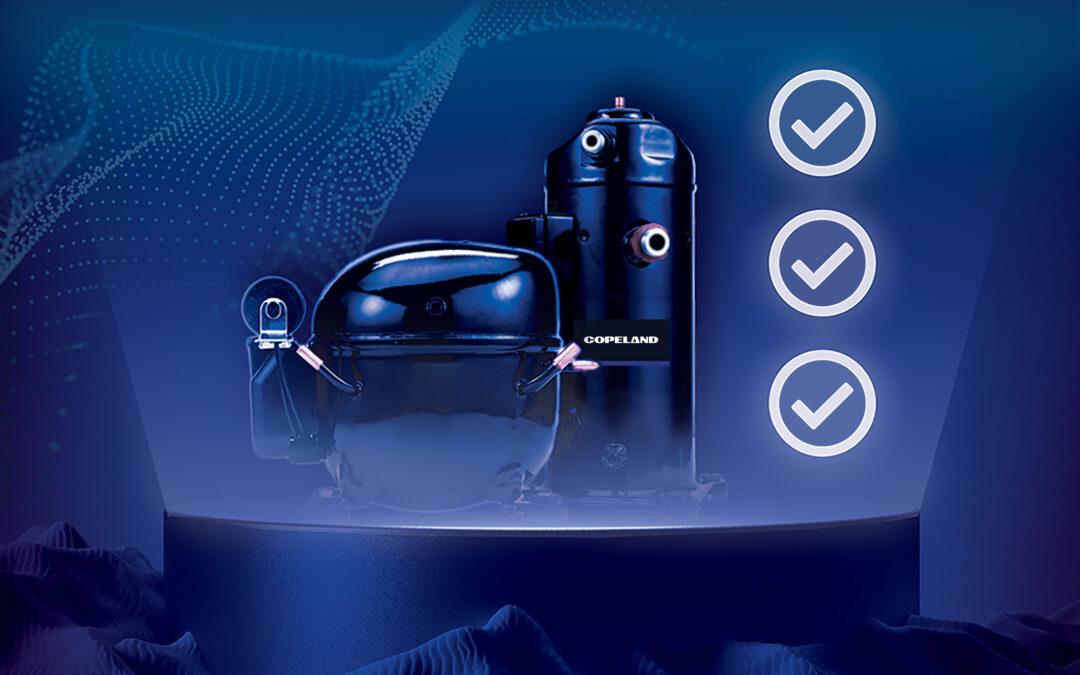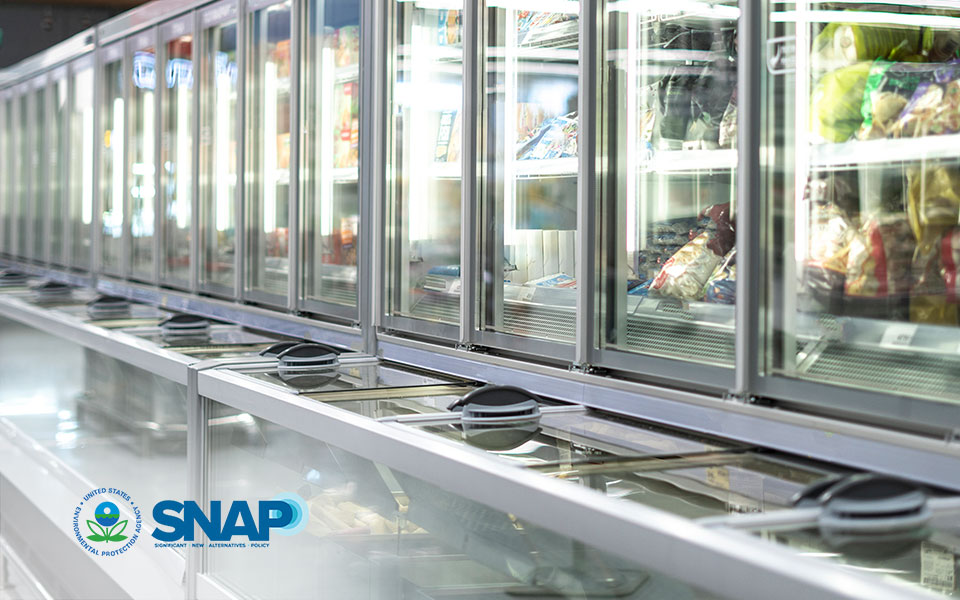Retrofit and remodel strategies to achieve lower-GWP refrigeration

*On June 1, 2023 Emerson’s Climate Technologies business became a new standalone company – Copeland. Though our name has changed, we are building on more than a century of HVACR innovation and industry leadership, and Copeland continues to offer the same products, industry stewardship, and learning opportunities you’ve grown to trust. Information found on this webpage posted before June 1, 2023 may contain our old name or branding, but you can be at ease knowing it was created with the knowledge and expertise of Copeland.
Three decades ago, supermarket operators had few options for selecting environmentally friendly refrigeration strategies. Now, as they look to retrofit or remodel older systems to comply with environmental regulations or achieve corporate sustainability goals, operators face an expanding selection of refrigeration architectures driven by the transition to lower-global warming potential (GWP) refrigerants. In a recent article that was published in Contracting Business, I explored several options that are available to supermarkets seeking a path to low-GWP refrigeration.

Lower-GWP refrigerant options continue to proliferate
Refrigerant selection is one of the most influential factors in a retrofit or remodel strategy, often serving as an underlying process to help operators achieve corporate sustainability goals. But refrigerant selection also dictates everything from refrigeration architecture to servicing requirements to the total cost of ownership (TCO).
As the U.S. continues to phase down the use of high-GWP refrigerants and phase out those with ozone depletion potential (ODP), manufacturers are beginning to utilize a variety of alternative refrigerants that offer varying degrees of GWP reduction. Of those that are considered both safe and approved for use, the following offer distinct advantages in support of sustainability:
-
- R-448/449A (low-GWP option) — Designed as a substitute for R-404A, R-448A offers a 65% reduction in GWP.
- R-513A (lower-GWP option) — R-513A, a substitute for R-134a, delivers a 56% reduction in GWP.
- A2L and A3 (lower- to lowest-GWP) — Mildly flammable A2L and flammable A3 (aka R-290 or propane) refrigerants are primarily used in self-contained systems and offer some of the most significant GWP reductions, and are some of the lower and lowest GWP options currently available,
- CO2 aka R-744 (lowest-GWP option) — Used only in systems designed to handle its unique properties, R-744 is a natural refrigerant with a GWP of 1.
Upgrading for a more sustainable future
Retrofitting or remodeling a refrigeration system to improve sustainability or comply with regulations is not simply a matter of selecting a lower-GWP refrigerant. Operators must also evaluate different refrigeration systems to determine how to meet their sustainability objectives and select a system that aligns with their operational priorities. At Emerson, we refer to this process as the Six S’s of evaluation criteria:
-
- Simple — to own and operate
- Serviceable — aligns with maintenance and operations capabilities
- Secure — provides safe operation and data security
- Stable — delivers reliable, dependable performance
- Smart — is equipped with electronic controls and connectivity to provide operational data and insights
- Sustainable — from financial, technical and environmental perspectives
In terms of retrofits and remodels, the following architectures are emerging as the leading options for meeting the wide range of operator preferences:
-
- Retrofit to R-448A/R-449A in existing centralized direct expansion (DX) systems — Replacing R-404A with R-448A allows operators to achieve significant sustainability improvements while preserving their existing system investments.
- Remote/outdoor condensing units (distributed) — Remote condensing units offer installation flexibility and reliability while using low-GWP R-448A. They are ideal for small, urban store formats or for large supermarkets deploying new refrigeration capabilities outside of their existing DX systems.
- Distributed systems — Operators can install multiple mini-racks or scroll packs in proximity to different refrigerated sections of a store. Using R-448A in this architecture can significantly reduce overall refrigerant charge while providing increased system reliability and energy efficiency.
- Macro-distributed systems (self-contained) — Used in large cases that integrate a single compressor, refrigeration circuit and electronic controls present a simple, flexible, stand-alone option for retrofits and remodels. This approach can be scaled from one to multiple units.
- Distributed scroll booster — This emerging distributed architecture uses low-pressure, lower-GWP R-513A for low- (LT) and medium-temperature (MT) circuits. A distributed scroll booster delivers improved energy efficiency and high reliability without added service complexities.
- CO2 transcritical booster — A CO2 transcritical booster system is an environmentally friendly alternative to high-GWP, centralized DX systems. While this architecture uses the refrigerant CO2 (R-744) for LT and MT loads, its unique performance characteristics increase both system complexities and TCO.
Ready to meet current and future needs
The decision to retrofit or remodel a refrigeration system must be made with a long-term perspective. Operators should expect to get 20 to 30 years of service from their refrigeration systems with proper maintenance and care. But the uncertainty caused by shifting environmental regulations, changing consumer expectations and ever-evolving technologies can complicate the planning process.
Emerson is committed to providing operators with the tools and insights to meet this challenge head on. We offer an array of compressors, condensing units, case controls and facility management technologies that can help operators to meet sustainability goals, comply with evolving regulations, and reduce the total equivalent warming impact (TEWI) of their refrigeration systems. We are also creating solutions that enable operators to make the transition to lower- and lowest-GWP refrigerants in ways that support their sustainability initiatives and long-term goals.
To learn more about how Emerson compressors and refrigeration technologies support different remodel and retrofit scenarios, read the full article.

A2L refrigerant regulation updates: what you need to know today
by Jennifer Butsch | Efficiency & Refrigerant Regulations
Preparing for the approval and safe use of A2Ls in commercial refrigeration applications The move...

Address Efficiency Mandates with Compression Technologies
by Joe Summers | Efficiency & Refrigerant Regulations
Strategies for complying with DOE and ENERGY STAR® in self-contained and remote condensing units...

EPA SNAP Rule 26 Approves, Modifies Use Conditions for A2L and A3 Refrigerants
by Jennifer Butsch | Efficiency & Refrigerant Regulations
On May 28, the Environmental Protection Agency (EPA) pre-published its Significant New...
The post Retrofit and Remodel Strategies to Achieve Lower-GWP Refrigeration appeared first on Copeland.